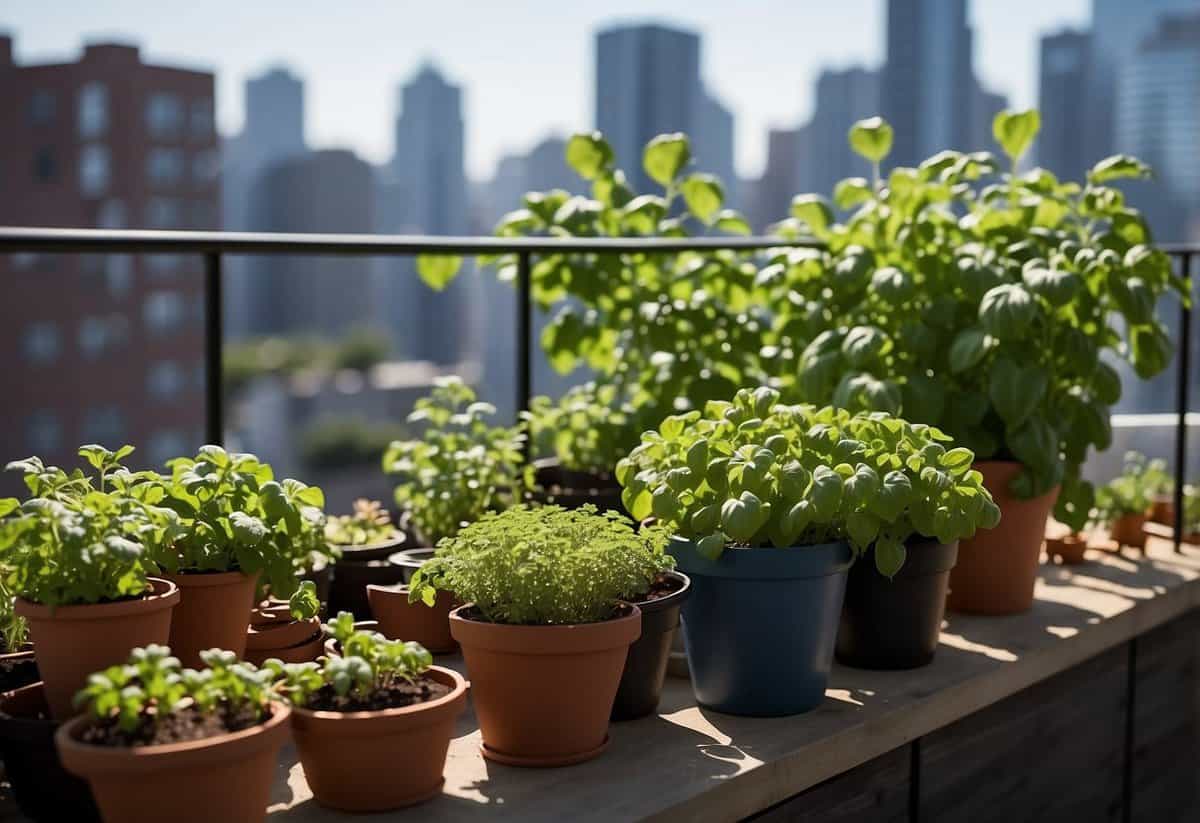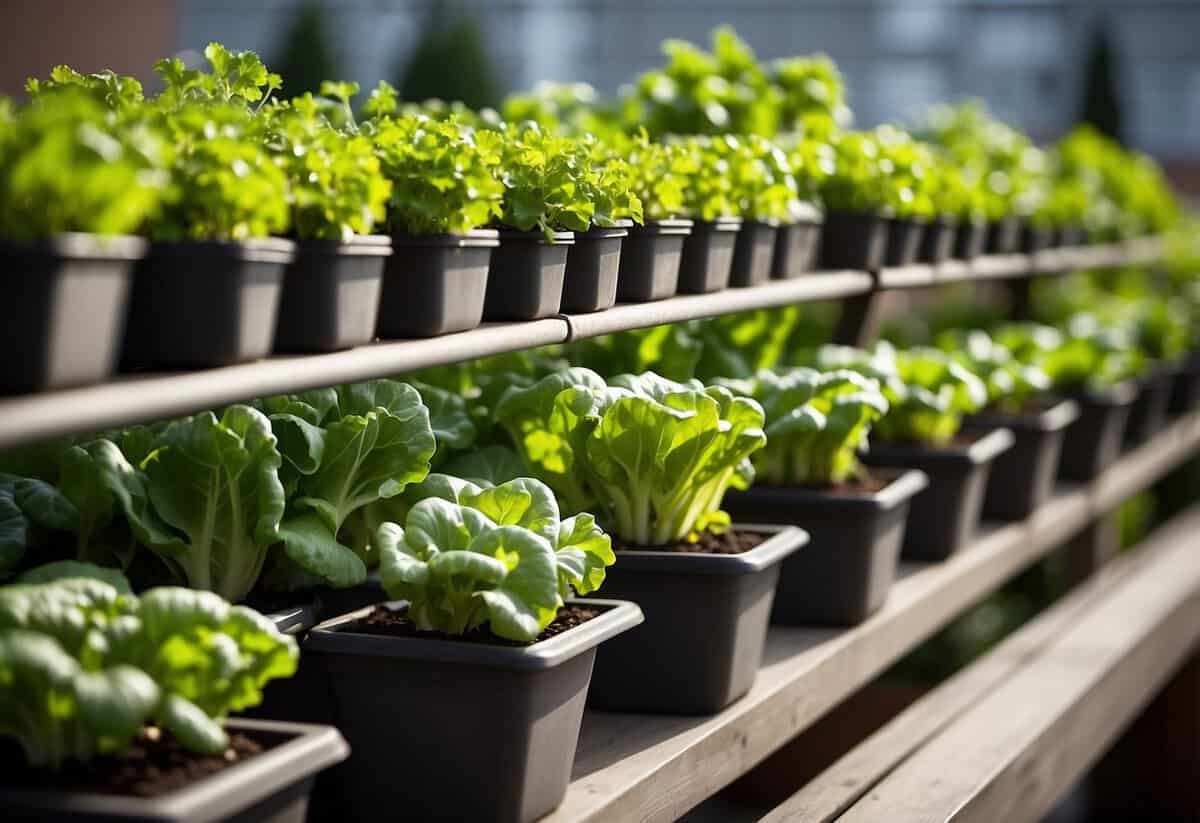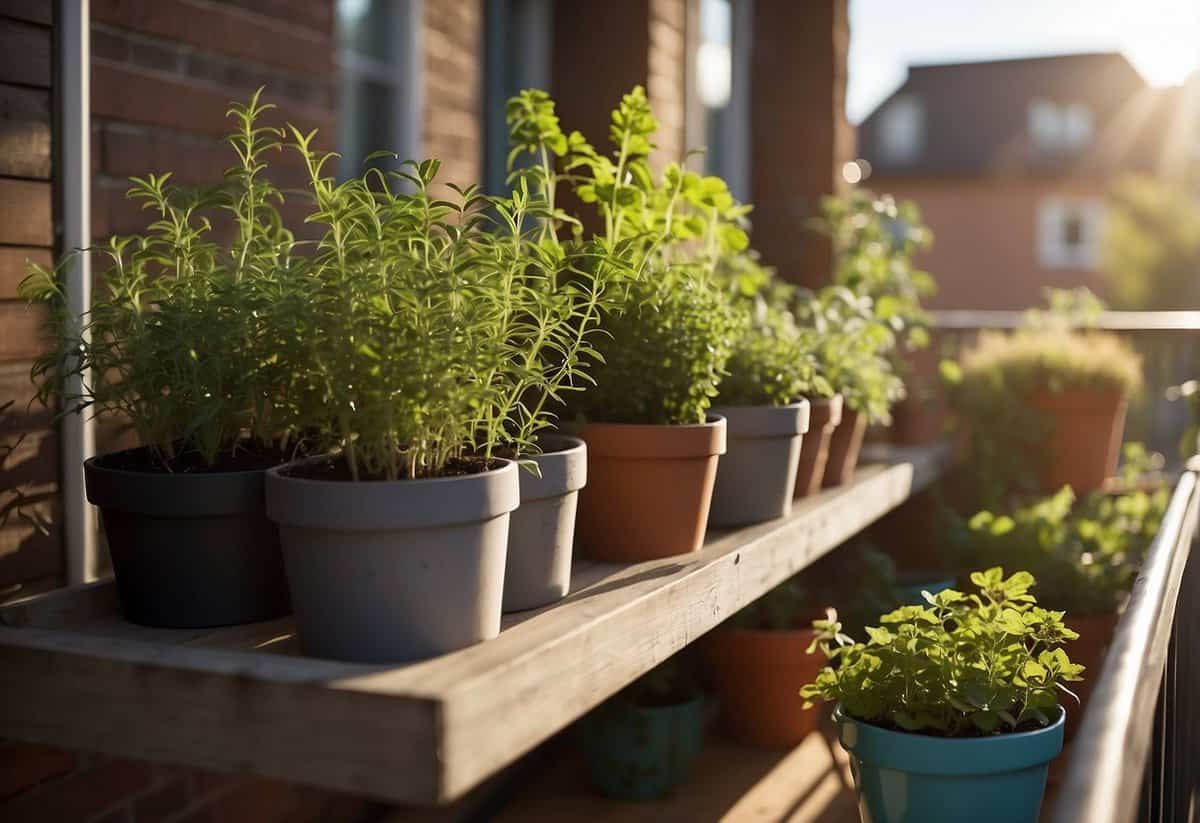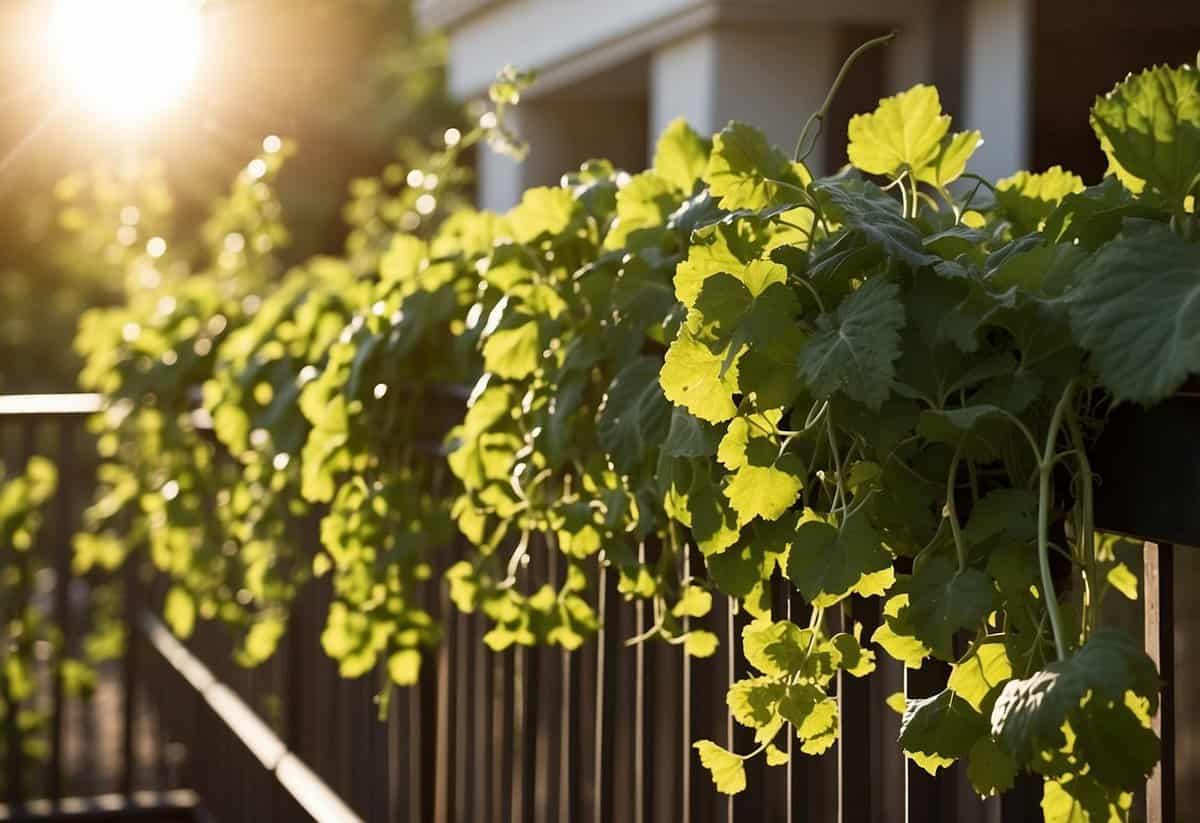Balcony Vegetable Garden Ideas: Grow Your Own Fresh Produce
Growing your own vegetables on a balcony is a great way to enjoy fresh produce without needing a large yard. You might think there’s not enough room, but even a small space can be transformed into a thriving vegetable garden. This article will help you discover easy and practical ideas for creating your own balcony vegetable garden.

With the right tips and techniques, you’ll be surprised at how much you can grow in pots and vertical planters. You don’t need to be an expert; with a little guidance, even beginners can get started and enjoy the benefits of home-grown vegetables.
1) Tomato Plant

Growing tomatoes on your balcony is both fun and rewarding.
Choose a sunny spot because tomatoes love sunlight. Use a large pot with good drainage.
Mix compost or aged manure into the soil for essential nutrients. Make sure the pH is between 6.0 to 6.8 for best results.
Water regularly but don’t overdo it. Tomatoes need consistent moisture. For more tips, check out this step-by-step guide.
2) Basil Herb

Basil is perfect for balcony gardens. It needs about 6-8 hours of sunlight each day. Make sure to use well-draining soil and water regularly.
Basil grows well in pots that are at least 6-8 inches deep. Prune it often to prevent it from getting too leggy and to encourage bushier growth.
You can easily start with small plants from a garden store and enjoy fresh basil in your dishes all summer long. Learn more tips about basil care.
3) Lettuce Greens

Lettuce greens are perfect for your balcony garden. They are easy to grow and don’t take up much space. You can grow varieties like romaine, spinach, and arugula.
These greens need about 4-6 hours of sunlight and can tolerate partial shade. Keep their soil consistently moist for the best results.
You can harvest lettuce leaves as needed, making them a convenient and fresh addition to your meals.
4) Strawberry Plants

Growing strawberries on your balcony is a great way to enjoy fresh fruit. To start, fill a pot with soil and dig a small hole for the plant.
Place the strawberry plant in the soil, then backfill. Once the plant begins to flower, mulch around the base to protect the fruit.
Consider creative growing methods like a vertical strawberry tube planter. Another good option is a strawberry planting tower, which saves space while providing plenty of berries.
5) Pepper Plant

Growing pepper plants on your balcony can be a fun and rewarding experience. They thrive in containers and need lots of sunlight. Use a pot that is at least 12 inches deep to ensure proper growth.
Water them regularly but don’t let the soil stay soggy. Mulching with organic materials helps keep the soil moist and reduces weeds.
Peppers benefit from a well-drained, nutrient-rich soil. You can add compost or a slow-release fertilizer for best results. For more tips on growing peppers, check out these pepper plant secrets.
6) Spinach Leaves

Growing spinach on your balcony is a fantastic idea. Spinach thrives in containers and doesn’t need a lot of space.
Sow your spinach seeds about 4-5 inches apart and water well. You can harvest the young leaves when they are around 2-3 inches long for the best taste.
Keep the soil slightly dry and avoid over-watering. Regularly sowing seeds between February and October will keep a fresh supply of spinach leaves for your meals. For more details, check how to grow spinach on a balcony.
7) Herb Garden Kit

A herb garden kit is perfect if you’re just starting out. These kits often include seeds for popular herbs like basil, parsley, and mint. They also come with pots and soil, making it easy for you to set everything up.
Using a kit saves time and ensures you have everything you need to start growing herbs on your balcony. You can find various kits that cater to different beginner levels. Some kits even come with instructions to guide you through the process.
For more information, visit this guide on creating a balcony herb garden.
8) Cucumber Vine

Growing a cucumber vine on your balcony is a wonderful idea. It can climb and utilize vertical space efficiently. You’ll need a sturdy trellis or support system.
Plant cucumber seeds in a large container and place them in a sunny spot. Ensure the soil is rich and well-drained. Water the plants regularly to keep the soil moist.
Train the vines to grow up the trellis to save space and keep the cucumbers off the ground. This helps in preventing rot and makes harvesting easier. Regularly check for pests and use natural remedies if needed.
9) Carrot Container

Growing carrots in containers is a fun and easy way to enjoy fresh produce. You’ll need deep pots, at least 12 inches, filled with high-quality potting soil.
When sowing seeds, plant them about 0.25 to 0.5 inches deep. After the seeds germinate and the sprouts are about 2 inches tall, thin them to about 2-3 inches apart.
Carrots need consistent watering to grow well. Ensure the soil stays moist but not waterlogged. Keeping your carrots in a sunny spot will help them thrive. For more tips on growing carrots in containers, check out this guide.
10) Radish Pots

Growing radishes in pots on your balcony is a great idea. They are fast-growing and very easy to care for. You can plant them in small pots, making them perfect for limited space.
Keep the soil moist for the best results, but avoid waterlogging. Regularly check the moisture to ensure the soil doesn’t dry out.
Radishes thrive in cool temperatures, ideally between 50-70 F (10-21 C). They usually germinate in 3-7 days, so you’ll see growth quickly. This makes them a satisfying choice for beginners. For more tips, check out Epic Gardening’s guide on radishes.
Choosing the Right Containers

Selecting the appropriate containers for your balcony vegetable garden is essential for plant health and growth. Key points to consider include the size and depth of the containers and the material they’re made from.
Size and Depth Considerations
Different vegetables have varying needs when it comes to container size and depth. Tomatoes, for instance, require deep containers—at least 12 inches deep—to accommodate their extensive root systems. Lettuces and herbs can thrive in shallower containers, around 6-8 inches deep.
Also, keep in mind that larger containers hold more soil, which retains moisture better. This can reduce watering frequency, making maintenance easier. Hanging baskets or window boxes might be suitable for smaller plants or herbs, but ensure they are deep enough for root development.
Small containers may limit root growth and cause plants to dry out quickly. Always match your container size to the specific needs of your chosen vegetables.
Material Types and Durability
The material of your containers can affect both the durability and the health of your plants. Clay pots are traditional and allow for good airflow, but they can be heavy and breakable. They also dry out quicker, which means more frequent watering.
Plastic containers are lighter and retain moisture longer, making them easier to move and manage. Look for UV-resistant plastic to avoid degradation over time.
Wooden planters add a natural look and are quite durable if treated properly. Make sure the wood is untreated or lined with plastic to prevent chemicals from leaching into the soil.
Metal containers can be durable but may heat up quickly, which might stress plant roots in sunny conditions. Consider lining metal containers with bubble wrap or using them in shaded areas to avoid overheating.
Choosing the right containers based on these considerations will help ensure your plants have the best conditions to thrive.
Maximizing Space in Small Balcony Gardens

Using space efficiently in small balcony gardens is key to growing more plants. Focus on vertical gardening solutions and smart use of railings and hanging planters.
Vertical Gardening Solutions
To maximize space, vertical gardens are a great choice. They let you grow plants upward rather than outward. You can install trellises or vertical planters against walls.
Shelves can also be added to hold small pots. Consider stacking plants at different heights to use all available space. Another option is a living wall, which can be built with modular units or pocket planters.
- Trellises: Great for climbing plants like tomatoes and beans.
- Shelves: Ideal for smaller pots and trailing plants.
- Living Walls: Offer a compact way to grow lots of plants in a small area.
Look for lightweight and durable materials that can handle outdoor conditions.
Using Railings and Hanging Planters
Using balcony railings and hanging planters helps free up floor space. Attach plant hangers to the top of the railings and let the plants hang down. This works well for trailing plants like ivy or small flowers.
You can also cover the railings with chicken wire to support climbing plants. Use the underside of the balcony’s ceiling by installing hooks to hang planters. This method is excellent for growing herbs and small vegetables.
- Plant Hangers: Easy to install and great for trailing plants.
- Chicken Wire on Railings: Supports climbing plants like beans and peas.
- Ceiling Hooks: Useful for hanging planters to grow herbs and small veggies.
By using these strategies, you can grow many more plants even in the smallest of spaces.
Soil and Fertilization Tips

Choosing the right soil and fertilization methods is essential for the growth and health of your balcony vegetable garden. You’ll want to focus on selecting the best soil mix for containers and deciding between organic and synthetic fertilizers.
Best Soil Mixes for Containers
For growing vegetables in containers, a high-quality potting mix is key. Unlike garden soil, potting mixes are lightweight and have excellent drainage properties. Look for a mix that includes peat moss, perlite, and vermiculite. These components help retain moisture while allowing excess water to drain away, preventing root rot.
Adding compost to your potting mix can boost nutrient levels. Compost improves soil structure, enhancing aeration and water retention. You can either buy a commercial potting mix or create your own by combining equal parts of high-quality compost, peat moss, and perlite.
When choosing a potting mix, avoid those containing synthetic chemicals or additives. Opt for organic mixes as they are safer for your plants and the environment.
Organic vs. Synthetic Fertilizers
Fertilizing your balcony garden is crucial for providing essential nutrients. Organic fertilizers come from natural sources like compost, manure, or bone meal. These fertilizers release nutrients slowly, improving soil health over time. They also encourage beneficial microorganisms and earthworms.
Synthetic fertilizers, on the other hand, are chemically manufactured. They provide nutrients quickly and in specific amounts. Though they can lead to rapid plant growth, overuse can harm the soil and even the plants.
Using a balanced approach with slow-release organic fertilizers can be beneficial. Consider adding a mix of compost and a well-balanced organic fertilizer to sustain plant growth throughout the season. Remember to follow the instructions on the fertilizer package to avoid over-fertilization, which can damage plants.







